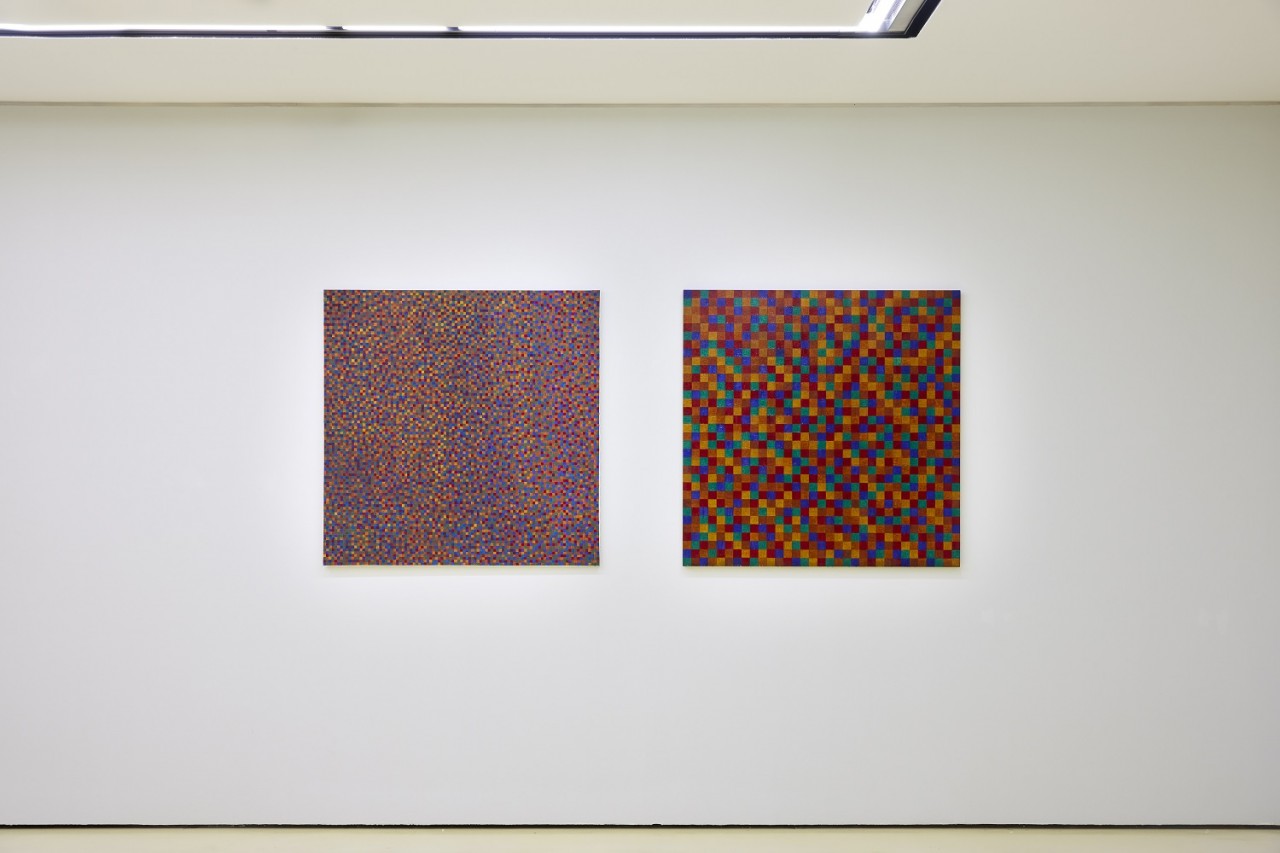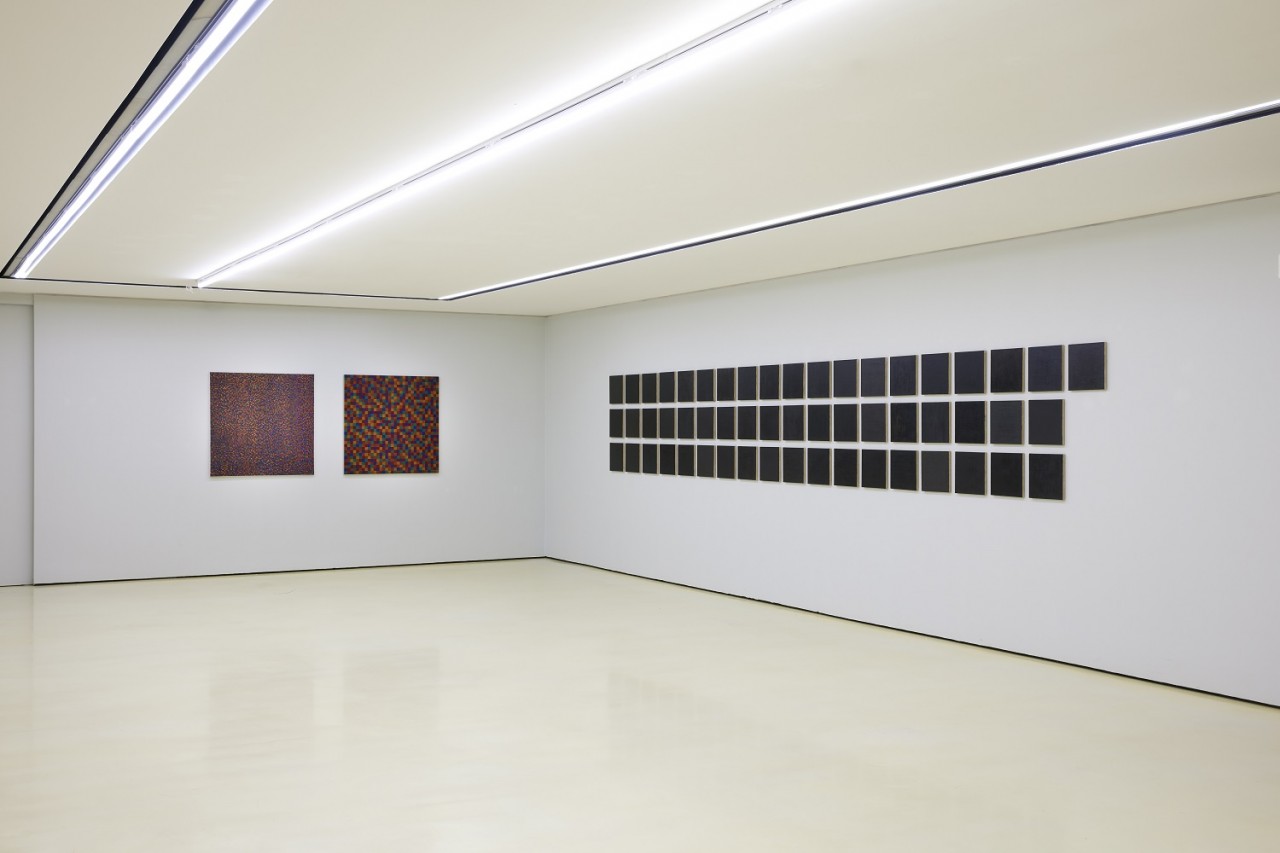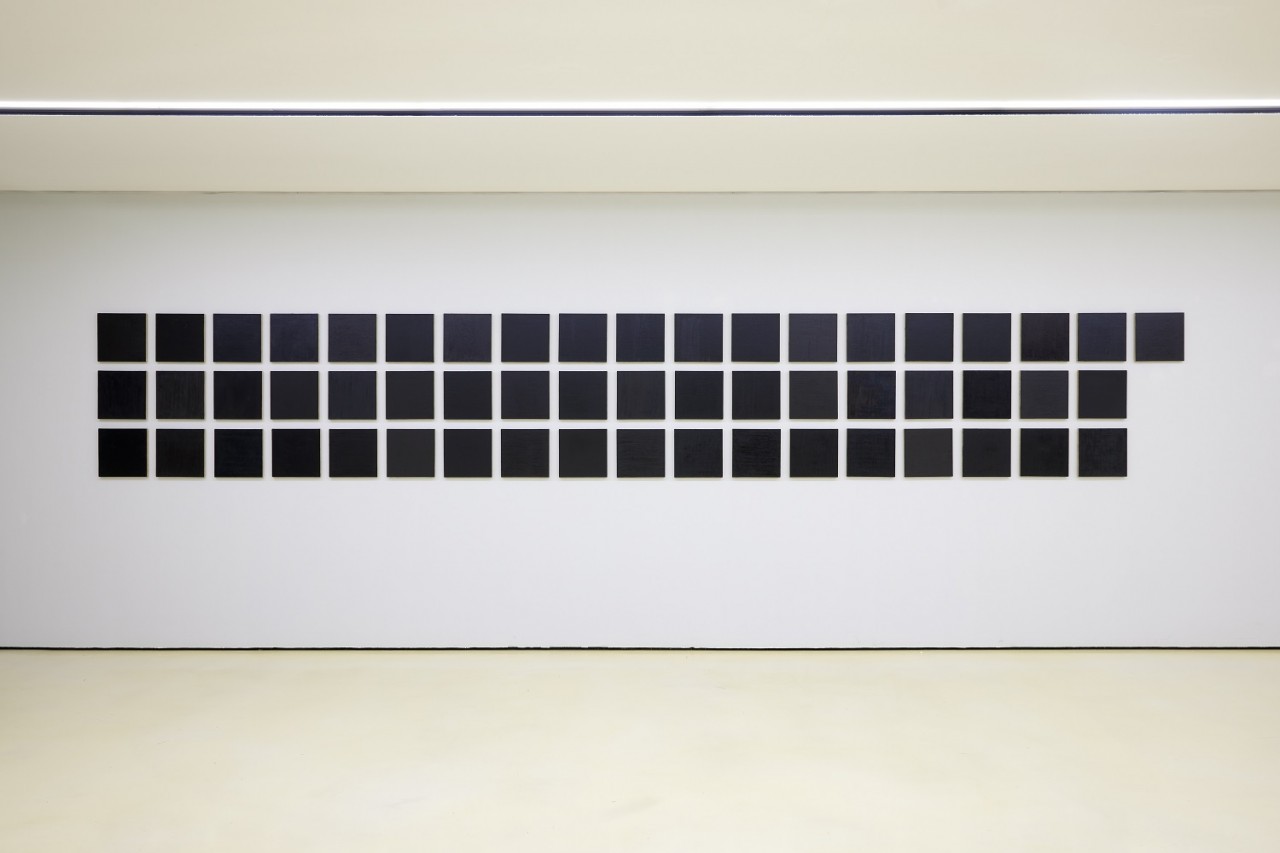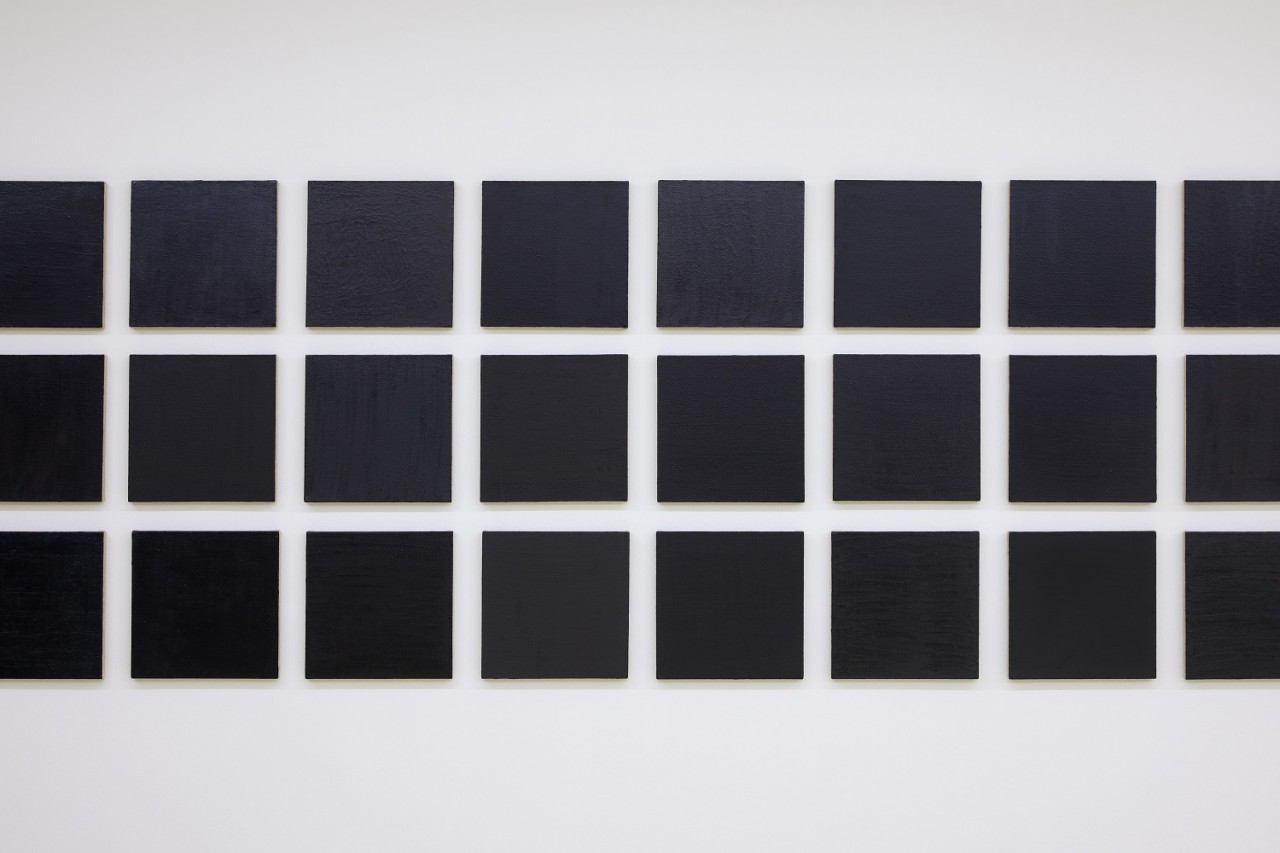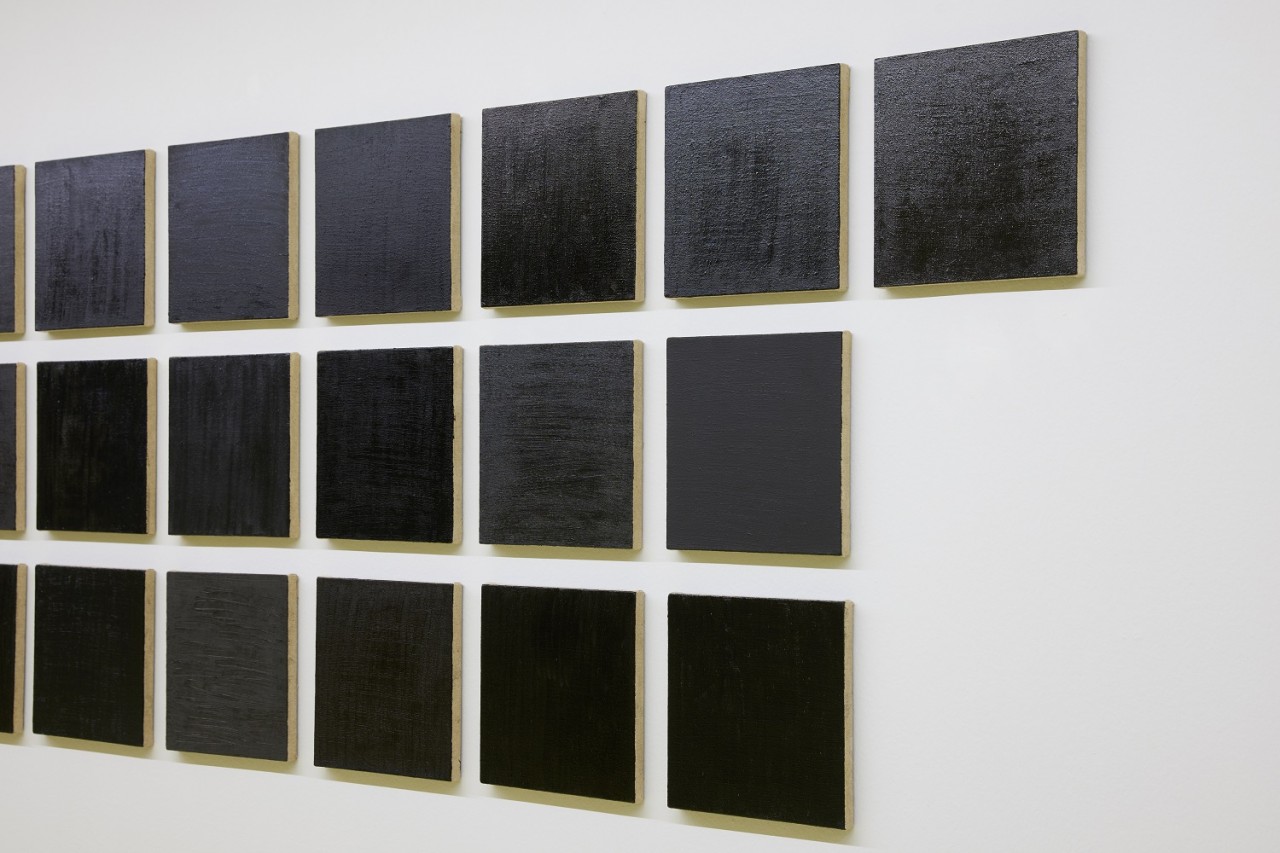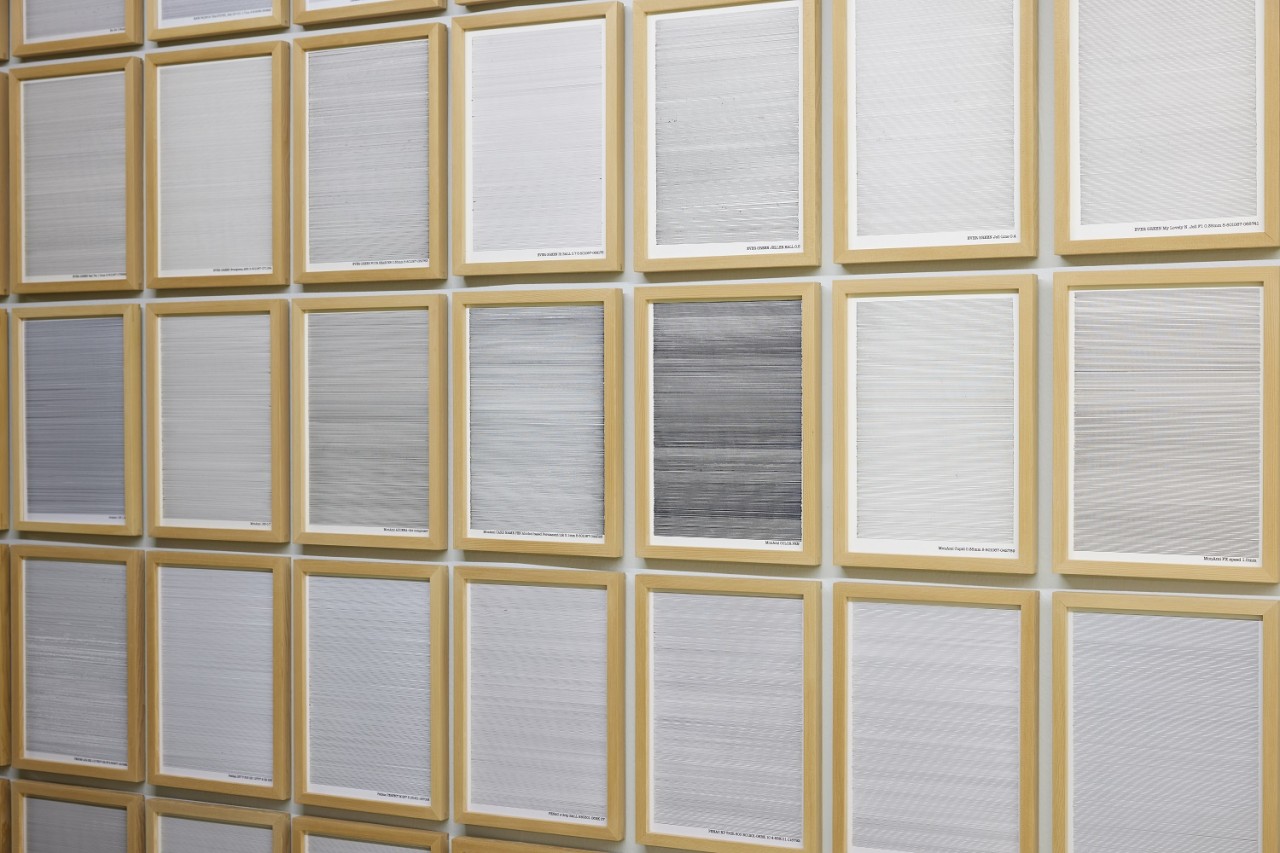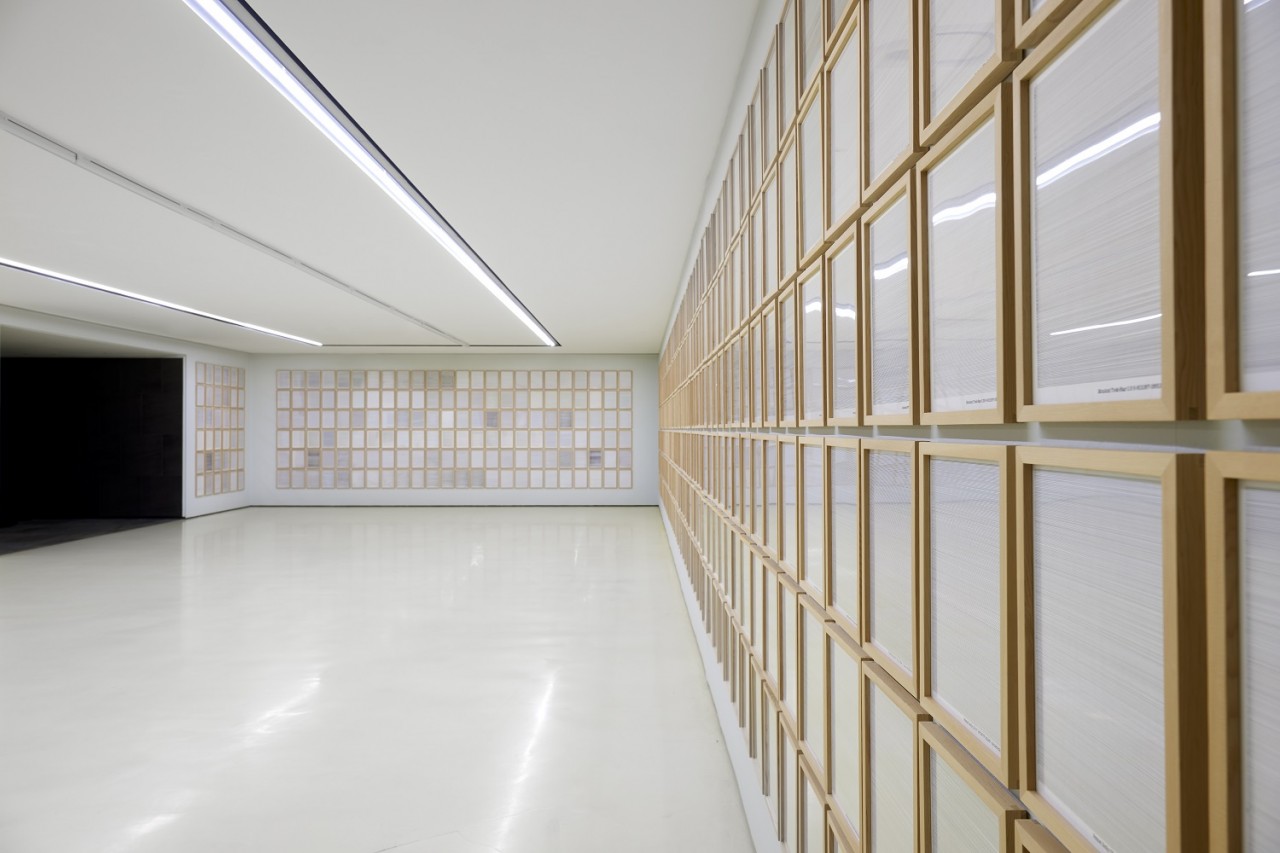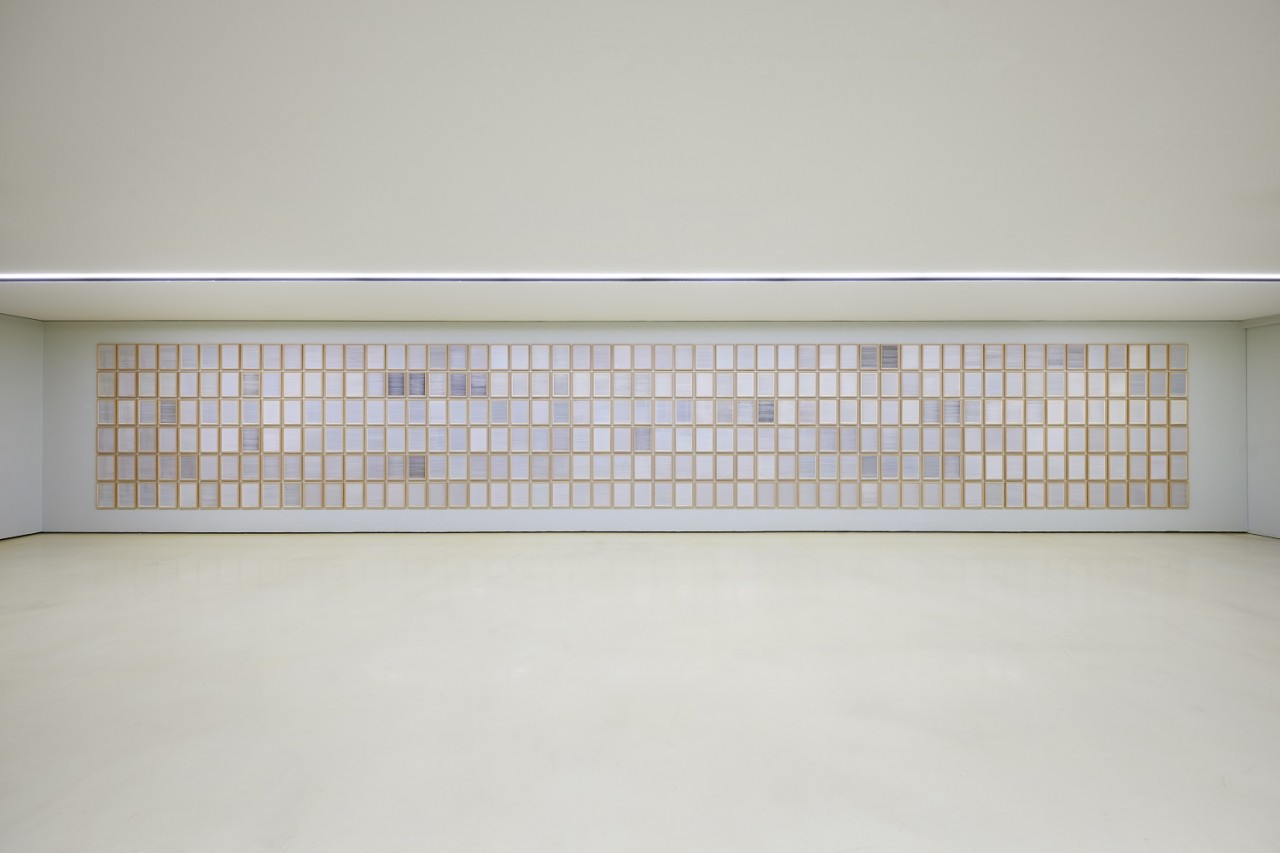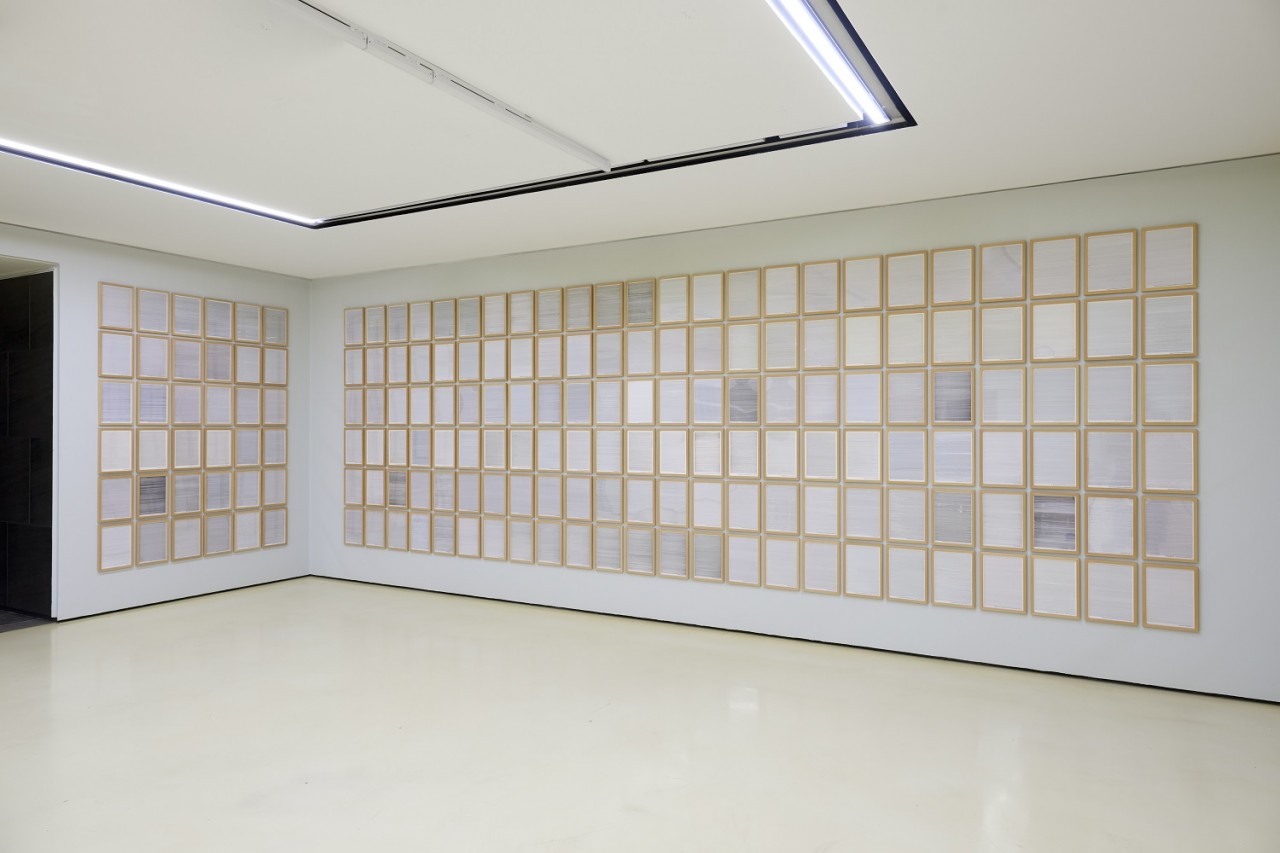Exhibitions

PERIGEE ARTIST #33 박미나
검은
2024.03.08. FRI ~
2024.04.27. SAT
<검은- 그 다채로운 향연>
신승오 (페리지갤러리 디렉터)
박미나 개인전 《검은》은 크게 세 개의 연작으로 나누어진다. <Black Pens>은 시판되고 있는 검은색 펜을 최대한 수집하고 이를 우리가 흔히 사용하는 A4 용지에 일률적인 간격으로 그어 나간 2006년부터 2024년까지 진행된 작업이다. 이렇게 완성된 498개의 드로잉 밑에는 펜의 상표와 고유번호가 적혀있고, 작가는 이를 따로 목록화 작업을 해 놓았다. <2014-Black>은 현재까지 판매되고 있는 검은색 유화물감을 수집하고 27.3x27.3cm의 정방형의 화면을 온전히 칠해 55개의 검은색 면을 만들었다. <2014-BGORRY>, <2024-BGORRY> 두 작업은 픽셀의 크기가 다를 뿐 6가지 색을 픽셀 하나하나에 채워 넣어 검은색을 색 분해해 놓은 것 같은 화면을 구성하고 있다. 그는 어떤 대상을 재현하는 방식이 아니라 회화가 가지고 있는 가장 기본적인 선과 색, 언어와 기호를 통해 회화의 본질에 대한 작업을 지속해서 해오고 있다. 그의 작업은 위에도 언급한 것처럼 재료를 수집하는 것에서 출발한다. 이번 전시에서도 자신이 파악하고 모을 수 있는 검은색의 펜과 유화 물감을 최대한 찾아서 모았다. 이러한 검은색이라는 재료는 색이라는 범주에서 이번 그의 작업이 가진 기본적인 범위가 된다. 이렇게 설정된 틀 안에서 그는 색을 칠하고 선을 긋는 행위에 ....
Black- Symphony of Euphoric Palette
Seung Oh Shin (Director of Perigee Gallery)
MeeNa Park’s solo exhibition Black is comprised of three major series. The first, Black Pens has been ongoing project from 2006 to 2024, involving the collection of various black pens available in the market. Park meticulously draws lines at uniform intervals on A4-sized copy paper. Underneath the completed 498 drawings, the brand and unique number of each pen are documented, and Park has cataloged them separately. The second, 2014-Black resolves around the collection of currently available black oil paints Park utilizes these paints to cover 55 square surfaces, each measuring 27.3x27.3cm, entirely in black. The third, 2014-BGORRY and 2024-BGORRY, differing only in pixel size, fills six colors into pixels, creating an appearance that seems to decompose black into various hues. Park continues to work on the essence of painting through basic elements such as lines, colors, language, and symbols rather than reproducing certain objects. Park’s creative process begins with the extensive collection of materials as mentioned above. For thi....
신승오 (페리지갤러리 디렉터)
박미나 개인전 《검은》은 크게 세 개의 연작으로 나누어진다. <Black Pens>은 시판되고 있는 검은색 펜을 최대한 수집하고 이를 우리가 흔히 사용하는 A4 용지에 일률적인 간격으로 그어 나간 2006년부터 2024년까지 진행된 작업이다. 이렇게 완성된 498개의 드로잉 밑에는 펜의 상표와 고유번호가 적혀있고, 작가는 이를 따로 목록화 작업을 해 놓았다. <2014-Black>은 현재까지 판매되고 있는 검은색 유화물감을 수집하고 27.3x27.3cm의 정방형의 화면을 온전히 칠해 55개의 검은색 면을 만들었다. <2014-BGORRY>, <2024-BGORRY> 두 작업은 픽셀의 크기가 다를 뿐 6가지 색을 픽셀 하나하나에 채워 넣어 검은색을 색 분해해 놓은 것 같은 화면을 구성하고 있다. 그는 어떤 대상을 재현하는 방식이 아니라 회화가 가지고 있는 가장 기본적인 선과 색, 언어와 기호를 통해 회화의 본질에 대한 작업을 지속해서 해오고 있다. 그의 작업은 위에도 언급한 것처럼 재료를 수집하는 것에서 출발한다. 이번 전시에서도 자신이 파악하고 모을 수 있는 검은색의 펜과 유화 물감을 최대한 찾아서 모았다. 이러한 검은색이라는 재료는 색이라는 범주에서 이번 그의 작업이 가진 기본적인 범위가 된다. 이렇게 설정된 틀 안에서 그는 색을 칠하고 선을 긋는 행위에 온전히 집중한다. 이 글은 《검은》 전시에 집중하여 작가가 전시를 통해 무엇을 이야기하는가보다 관객의 입장에서 무엇을 보고 읽어나갈 수 있는지 살펴보려 한다. 따라서 이 글은 필자가 작가와 나눈 인터뷰를 바탕으로 하여 한 명의 관객의 시선으로 전시를 보면서 생각나는 단편들을 파편적으로 기술하는 일이 될 것이다.
전시장에 들어서면 눈에 가장 먼저 들어오는 것은 당연하게도 검은색이다. 검은색이라는 하나의 단어로 함축되어 있는 이 색은 작가에 의해 한 자리에 펼쳐지면서 그 차이를 드러낸다. 여러 회사에서 만들어진 다양한 종류의 펜과 물감은 모두 검은색이지만 하나하나가 다른 느낌으로 다가온다. 이렇게 구분과 대조를 통해 보는 것이 중요한 이유는 이것이 우리의 고정된 관념을 말랑말랑하게 만드는 첫 단계이기 때문이다. 이러한 차이를 인식하게 되면서 우리는 자연스럽게 검은색이라는 것의 정의가 정확하게 무엇인지에 대해 고민하게 된다. 작가에 의하면 회화를 교육받은 작가는 먼저 시판되는 무채색으로 분류되는 검은색 물감은 사용하지 않고 여러 유채색을 조합하여 만들어 사용하도록 교육받는다고 한다. 여러 유채색이 섞인 검은색은 그것의 색상과 비율의 정도에 따라 모두 다른 검은색이 생성될 것이다. 그렇다면 우리는 실제로 시판되는 무채색의 검은색과 유채색으로 만들어진 검은색을 시각적으로 구분할 수 있을까? 그럼 우리는 무엇을 검은색이라 지칭하는가? 이런 생각이 꼬리에 꼬리를 물고 이어진다. 그의 작업은 우리에게 언제부터인지 모르지만, 반복적으로 학습되어 어떤 틀로 익숙한 것에서 다른 것을 발견하는 낯선 상황을 자연스럽게 유발한다. 아마도 그가 이러한 작업을 한꺼번에 펼쳐 놓는 전시의 방식은 우리가 머리로 상상하고 막연히 결론을 내리는 고정된 틀에서 벗어나는 환경을 만들기 위한 것으로 보인다. 이는 단일한 시선으로 주어진 대상을 흐릿하게 보는 것이 아니라 여기저기를 꼼꼼히 살피며 날카롭고 명확하게 다시 살펴보는 일이다. 따라서 그가 최대한 하나의 범주를 설정하고 색을 끌어모으는 이유는 작가 자신을 표준화된 행위자이며 규격화된 행동의 모델로 생각하기 때문일 것이다. 이렇게 본다면 작가가 명확하게 설정한 규칙을 자기 작업의 기본값이자 좌표 찍기라고 이야기하는 것이 이해된다.
이제 눈을 돌려 전시장에서 벽을 가득 채운 <Black Pens>연작을 보니 작가의 강박적 집착이 느껴져 그 분위기에 압도된다. 그렇다 보니 그가 작업을 위해 색을 칠하고 선을 긋는 행위 그 자체가 궁금해진다. 2006년부터 시작된 축적된 시간 동안 반복적으로 수행하는 이 작업은 선 긋는 행위의 과정과 흔적을 고스란히 담고 있을 수밖에 없다. 그래서 우리는 작품들 앞에서 작가가 A4 용지 하나를 놓고 펜과 자를 사용해 동일한 행위를 반복하는 작업의 과정과 그 시간을 거꾸로 상상할 수 있다. 이렇게 연결되면 작가의 고통을 수반하는 집요한 기계적 수행의 과정에서 우리는 또 다른 것을 읽게 된다. 우선 그가 만들어 놓은 기본값과 같은 규칙을 통해 그의 주관적 표현은 완벽하게 작업에서 배제될 수 있는가를 생각해 본다. 똑같은 행위를 수없이 반복하기는 어렵다. 그것도 의식적인 통제를 통해 획득하는 것은 더욱 그렇다. 횟수를 거듭해 나갈수록 무의식적 행동에 가까워지므로 기계처럼 정확하게 항상 동일한 결과물은 만들어 낼 수 없다. 그렇기에 작가는 동일한 행위를 기계적으로 반복하지만, 그의 드로잉에 사실상 동일한 선은 없다. 이런 선들이 모인 498개의 드로잉 설치가 흥미로운 것은 수많은 선이 관객에게 어떻게 감각될지 그 결과는 예측할 수 없다는 점이다. 다시 말해 <Black Pens>연작은 명확한 기준과 범위의 설정과 작가의 기계적 행위를 통해 완성되지만, 그것이 모여 펼쳐진 장면은 우연적인 산물로 보이기도 한다. 이처럼 작품의 제작 과정에서 그의 행위는 의식적 통제와 무의식적 반복 사이에서 어떤 사고의 흐름을 드러낸다. 이런 행위는 완벽하게 이성적이거나 감정적이거나 의식적이거나 무의식적이거나 주관적이거나 객관적일 수 없는 그 경계의 범위를 그 자신의 행위를 통해 실천적으로 보여준다.
그렇다면 작가에게 경계란 무엇인가로 생각이 이동한다. 이 이야기를 하기 위해서는 다시 펜과 물감을 수집하는 시작점으로 돌아가야 한다. 이번에 모은 검은색은 모든 것을 수집한 것이 아니라 최대한 모은 것이라는 표현이 정확할 것이다. 이들은 앞으로도 새로 출시될 수 있는 가능성이 있는 대상이며, 그렇지 않은 경우에도 작가가 아직 발견하지 못한 것이 있을지도 모르기 때문이다. 이렇게 본다면 세상은 경계가 없이 무한한 것이 아니라 오히려 유한하지만, 우리가 인간의 인식으로 파악할 수 있는 것이 한계가 있기에 그 너머에 있는 것을 무한하게 있을 것으로 생각한다는 작가의 말에 수긍이 간다. 이러한 그의 수집 이후에 수행하는 반복적 행위는 가능한 것의 한계를 탐구하는 본질적인 방법이 된다. 이제 작품으로 다가가 색으로 구분되는 픽셀을 다시 세밀하게 살펴보자. <2024-BGORRY>을 가까이에서 보면 하나의 픽셀마다 동일한 붓질을 사용했지만, 다른 표면의 질감이 눈에 띈다. 또한 색 면 사이의 경계가 세심하게 칠해져 있음을 알 수 있다. 특히나 눈에 띄는 점은 하나와 하나의 사이를 연결하면서도 분리하는 경계를 표현하는 것에 세심하게 집중하고 있다는 점이다. 그 경계들은 자신의 영역을 공고히 하면서도 그 경계에 접해 있는 다른 색들을 생기 있게 느끼도록 만든다. 작가는 이러한 색의 경계들이 멀리서 보았을 때 서로 분리되어 보이는 것이 아니라 그 경계가 모호하게 보이는 순간이 생기면 오히려 각자의 영역에 색 면이 잘 구현된 것이라 이야기한다. 그렇기에 우리가 그의 작업에서 바라봐야 하는 것은 화면 가까이에서 보이는 명확한 구분과 함께 한 발 뒤에서 보이는 서로 당기고 밀어내는 그 미묘한 움직임의 차이이다. 그 경계는 무엇인가를 명확하게 지시하면서도 그것을 제외한 주변의 것을 동시에 보게 만들어 우리의 시선은 그 색 면을 보면서 안도 밖도 아닌 경계선에 머문다. 그리고 여기서 느껴지는 묘한 감각은 정해져 있는 길을 이탈하거나 혹은 살짝 비켜날 때 그 경계의 정체가 비로소 발견되는 것과 같이 자연스럽게 우리의 인식과 그 틈에 스며든다.
마지막으로 ‘나’의 눈에 스며든 검은색의 의미 그 자체를 생각해 본다. 우리 주변에 관습적으로 생겨난 검은색이 가진 언어와 기호의 의미를 떠올려 보면 검은 옷은 단순하고 중후한 느낌, 사제들의 권위, 죽음에 대한 애도를 상징한다. 또한 오방색으로서 북쪽의 방위를, 검은 까마귀와 고양이는 불길함을 의미하기도 한다. 사람에게 대입하면 검은색은 흑인을 비하하는 차별의 단어로도 사용되고, 마음이 사악한 것을 빗대어 말하기도 한다. 그리고 검은색은 칠흑 같은 밤이라는 표현처럼 어둠을 상징하며, 이러한 빛의 부재는 사실 색이 존재할 수 없는 상황이다. 우리에게 빛이 없다는 것은 그 자체로 죽음을 의미하며, 이에 따라 두려움과 불안을 유발한다. 이것은 예를 들면 우주의 검은 구멍인 블랙홀처럼 무엇인가가 구별되지 않는 상태의 무(無)로 돌아가게 만드는 것을 의미하기도 한다. 이렇듯 다양한 상징 체계는 하얀 종이 위에 검은색으로 쓰는 언어와 기호들을 떠오르게 한다. 이는 무엇을 새롭게 채워나가는 충만함과 그로 인해 무엇인가가 지워진 것 같은 여러 가지의 의미가 공존하는 상징과 언어의 체계가 가진 본질적 모습이다. 하지만 깊은 물 속을 볼 때나 머나먼 우주를 상상하는 것과 같이 검은색이 가진 어두움 그 자체는 우리에게 그 심연에 잠재된 아직 발견하지 못한 무엇인가를 상상하게 만든다. 이렇게 본다면 검은색은 경계가 없는 무한한 잠재성을 지닌 시공간이다. 그러므로 검은색은 완벽하게 불안정한 상태이며, 이 조용한 표면은 채워짐과 비워짐, 결여와 초과를 동시에 드러낸다. 그리고 이러한 성질은 우리가 추구하는 완성이라는 본질이 가진 미완성 그 자체를 드러낸다. 따라서 검은색에 대한 다양한 접근의 가능성을 가진 이번 전시에서 이를 보고 읽는다는 것은 우리에게 형성된 인식의 틀이 가진 외연을 자연스럽게 확장하는 일이 될지도 모르겠다. 이처럼 그의 작업에서 검은색은 작가의 집요한 반복을 통해 주관적인 판단과 취향을 배제하지만, 이는 오히려 우리 내부의 헛된 객관적 지지대를 조용히 무너뜨리는 일이 된다.
지금까지 살펴본 것과 같이 작가는 검은색이라는 소재로 여러 연작을 완성한다. 하지만 그 이후 전시에서 그것들은 완성이라는 고정된 틀에서 이탈해 다양한 의미로 분화된다. 이처럼 《검은》은 관객이 어떤 것을 보고 어떤 길을 선택하는가에 따라 다른 것으로 환원될 가능성으로 넘치는 전시가 된다. 그렇기에 작가는 오히려 자신이 설정한 의도와는 다른 방식으로 자기 작품을 읽어버리는 오역에 가까운 이야기를 환영할지도 모르겠다. 다시 말해 보는 이들이 그의 작업 앞에서 경직되어 버리지 않고, 작가가 고정된 것, 한정된 것을 또 다른 차원에서 포용하는 것과 같이 관객 스스로가 그의 작업의 경계를 넘어 최대한의 상상력을 발휘하길 바라는 것이다. 이는 형식적 장치와 이를 바라보는 직관이 서로 배척하는 것이 아니라 자연스러운 상호작용을 일으키는 일이다. 그리고 서로의 한계를 통해 그 한계를 넘어서는 일처럼 보이기도 한다. 따라서 우리는 그저 눈을 열어 크게 뜨고 모든 것을 보려 시도하면서, 하나씩 눈에 들어오면서 느끼는 모든 것에 마음을 움직이기만 하면 된다. 그러기 위해서 우리는 그가 펼쳐 놓은 작업을 충분히 이리 보고 저리 보며, 자기 눈으로 그것들을 직접 들추어보아야 한다. 물론 이는 쉬운 일이 아니지만 우리는 작가와 같이 집요하게 무엇인가를 보기 위해 연습하고 행동으로 옮길 때에야 비로소 이미 담긴 이야기에서 벗어나 아직 발화되지 않은 낯선 이야기를 발견하게 될 것이다. 결국 박미나의 작업은 우리에게 어떤 결과에 머무는 종착점이 아니라 그다음으로 가기 위한 도약대이자 출발점이다. 그리고 이것이 우리가 그의 작업을 적극적으로 읽으려 애써야 하는 이유이다.
Seung Oh Shin (Director of Perigee Gallery)
MeeNa Park’s solo exhibition Black is comprised of three major series. The first, Black Pens has been ongoing project from 2006 to 2024, involving the collection of various black pens available in the market. Park meticulously draws lines at uniform intervals on A4-sized copy paper. Underneath the completed 498 drawings, the brand and unique number of each pen are documented, and Park has cataloged them separately. The second, 2014-Black resolves around the collection of currently available black oil paints Park utilizes these paints to cover 55 square surfaces, each measuring 27.3x27.3cm, entirely in black. The third, 2014-BGORRY and 2024-BGORRY, differing only in pixel size, fills six colors into pixels, creating an appearance that seems to decompose black into various hues. Park continues to work on the essence of painting through basic elements such as lines, colors, language, and symbols rather than reproducing certain objects. Park’s creative process begins with the extensive collection of materials as mentioned above. For this exhibition, she gathered all identifiable black pens and oil paints available. The use of material in black sets the foundational scope for her current work within the color category, where she focuses entirely on coloring and drawing lines within the predefined framework. This preface is intended to encourage audiences to explore and interpret what they see in Black rather than emphasizing Park’s specific intentions for the exhibition. Therefore, this preface remains in a partial account, based on an interview with Park, describing fragments of thoughts that come to mind from the perspective of one audience member.
When you enter the gallery, the first thing that catches your eye is the color “black”. This single word encompasses various shades, each revealed as Park spreads different types of pens and paints, all in black, made by different companies. While they may all be classified as black, each one evokes a distinct feeling. The significance of recognizing these differences lies in challenging our fixed notions, taking the first step towards flexibility. Park highlights that those who receive painting education are initially discouraged from using commercially available achromatic black paint. Instead, they are encouraged to create their own version by combining various chromatic colors. The resulting black, mixed with different chromatic colors, produces a range of blacks depending on the color and ratio. This prompts us to question what we truly define as black. Can we visually distinguish between the achromatic black sold in the market and the black created with chromatic colors? These thoughts lead us to ponder the very essence of black. Her work creates a unique situation where we discover something unfamiliar, breaking away from the repetitively learned concepts. Presenting this work in an exhibition seems to create an environment that challenges the fixed frames we imagine in our minds. It's not just about observing an object with a single gaze but carefully exploring and critically reevaluating our perceptions. The process of collecting colors and establishing rules and parameters in her work likely stems from her perception of herself as a standardized performer and a model of standardized behavior. This approach underscores why she sees formulating clear rules in her work as the foundational principles of practice and the guiding axis of the creative process. The series of works titled Black Pens which fill the gallery wall, immerse the viewer in Park's profound obsession and create an overwhelming atmosphere. I found myself intrigued by the process of coloring and drawing lines in her work. Executed repeatedly from 2006 to 2024, these works must encapsulate the process and remnants of the line-drawing activity.
When standing in front of these pieces, one can envision the meticulous process and time invested by Park as she places a copy paper and employs a pen and ruler to repeat the same action. Amidst the mechanical repetition accompanied by a sense of effort, a deeper narrative emerges. The question arises whether her subjective expression can truly be excluded from the work, given the rules she has imposed. Replicating the same act numerous times, especially under conscious control, is challenging. With increasing repetitions, it approaches unconscious behavior, making it impossible to achieve an exact machine-like precision. Thus, while Park's action appears as mechanically repeated, her drawings reveal no truly identical lines. The installation of 498 drawings, brought together by these lines, introduces an intriguing element – the unpredictability of how the audience will perceive the myriad lines. Although the series Black Pens is meticulously executed through clear standards, range settings, and Park's mechanical behavior, the resulting scene unfolds as a product of randomness. Throughout the production process, her actions expose a subtle interplay between conscious control and unconscious repetition, illustrating the boundary of a range that defies perfect categorization as rational, emotional, conscious, unconscious, subjective, or objective.
What does the concept of a boundary mean to Park? To explore this, let's trace back to the initial step of collecting pens and paints. The black amassed on this occasion doesn't encompass everything collectible, but it would be accurate to say it includes as much as possible. These are items that could potentially debut in the market in the future, and there might be discoveries yet to unfold even for Park. Viewing it from this perspective, the world is not boundlessly infinite, but rather finite. Yet, we resonate with Park's assertion that we assume an infinite realm beyond because our understanding is limited by human perception. The repetitive act she undertakes after such a collection becomes a crucial method for probing the boundaries of what is achievable. Now, let's delve into the artwork and closely examine the pixels distinguished by color. In 2024-BGORRY, each pixel employs the same brushstroke, yet the texture of a distinct surface is evident. Additionally, meticulously painted boundaries between the colored surfaces are observable. Notably, she concentrates on expressing the boundary that connects and separates each element. These boundaries assert their own space while infusing vibrancy into the adjacent colors. Park suggests that when viewing these color boundaries from a distance, a moment of ambiguity may emerge, creating a cohesive presentation rather than separate entities. Therefore, the focus in her work should be on the clear distinction observed up close and the subtle interplay of differences seen from a step back, a dynamic of pull and push. These boundaries not only convey something distinct but also draw attention to the surroundings they exclude. Consequently, our gaze remains fixed on the boundary line while surveying the painted surface. The peculiar sensation experienced here naturally infiltrates our perception and its gaps, akin to the revelation of the boundary's identity when diverging from the established path or slightly deviating from it.
Finally, I contemplate the significance of the black color that permeated 'my' vision. Examining the linguistic and symbolic implications of the black hue that traditionally surrounds us, black attire often symbolizes simplicity, solemnity, the authority of priests, and mourning for the departed. Additionally, as one of the "five colors," it represents the north, while black crows and cats are associated with ominousness. When applied to people, black has been employed in a discriminatory manner, belittling black individuals, and metaphorically characterizing a malevolent heart. Furthermore, black symbolizes darkness, as seen in expressions like pitch-black night, representing a state where color cannot exist due to the absence of light. This absence of light, akin to death for us, instills fear and anxiety. It also signifies a return to a state of nothingness, resembling the black hole in the universe, where distinctions cease to exist. These diverse symbolic systems prompt reflection on the language and symbols written in black on white paper. This encapsulates the fundamental nature of a system where the act of filling something new coexists with the complex notion that something may have been erased. However, similar to gazing into deep waters or contemplating the vast universe, the inherent darkness of black inspires thoughts of undiscovered realms latent in our abyss. Black, in this context, becomes a space-time with infinite potential, free from boundaries. It represents a perfectly unstable state, wherein the quiet surface simultaneously reveals filling and emptying, lack and excess. This intrinsic quality exposes the incompleteness that underlies our pursuit of essence and completion. Therefore, this exhibition, exploring various approaches to black, serves as a platform to organically expand our perceptual framework while examining and deciphering the imprints within us. In her artistic endeavors, Park eliminates subjective judgment and taste by obsessively repeating the use of black. Paradoxically, this approach quietly dismantles our futile objective support, highlighting the ephemeral and subjective nature of such constructs.
As observed thus far, Park creates multiple series utilizing the black material. However, following this, these series branch out into various interpretations, straying from the fixed framework of completion within the exhibition. Consequently, Black transforms into an exhibition brimming with potential to be interpreted differently depending on the observer and the path they choose. Park may even welcome a narrative resembling a mistranslation, where the audience reads her work in a way different from her original intention. In essence, she desires that viewers in front of her work remain open-minded, not constrained by rigidity, and that the audience themselves traverse the boundaries of her work, unleashing their maximum imagination—much like Park embracing fixed and limited elements in another dimension. This interaction unfolds as a natural interplay between the formal device and the intuition observing it, without rejecting each other. It appears to transcend limits through the mutual exploration of each other's boundaries. Therefore, our task is to open our eyes wide, attempting to see everything and allowing our hearts to embrace each element that comes into our view one by one. Achieving this requires thorough examination of Park's laid-out works, looking at them directly with our eyes. While certainly not an effortless endeavor, practicing the persistent observation demonstrated by Park enables us to uncover a peculiar narrative that remains untold within the already contained story. Ultimately, MeeNa Park’s work is not a terminal point where we settle for a particular result; rather, it serves as a springboard and starting point for what comes next. This underscores the need for a concerted effort to actively engage with and decipher her work.



